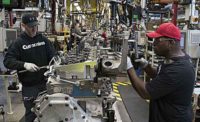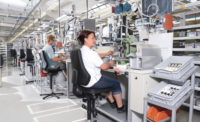
Many people want to be a star in their profession, regardless of the challenges and obstacles they have to overcome. Many manufacturers have the same ambition, regardless of how long they’ve been in business or the products they make.
Since July 1982, the Occupational Safety and Health Administration (OSHA) has helped thousands of manufacturers become a Star through its Voluntary Protection Programs (VPP).
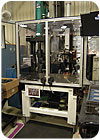
TRW Vehicle Safety Systems has made its workstations more ergonomic. After positioning an air bag inflator over the copper circle (at right), the worker flips a switch, activating nearby pivoting bars to hold the inflator in place as it is welded. Previously, the worker had to manually lift and lower a cover to keep the inflator in place. The station also may be hydraulically raised or lowered. Photo courtesy TRW Vehicle Safety Systems
More Work Than Wishing
VPP requires management, labor and OSHA to work cooperatively and proactively to prevent fatalities, injuries and illnesses through a safety and health system focused on hazard prevention and control; worksite analysis; training; and management commitment and worker involvement. Union support is required for applicants represented by a bargaining unit.To participate, a manufacturer must submit an extensive application to OSHA and undergo a rigorous onsite evaluation by a team of safety and health professionals. The onsite evaluation lasts three to five days. On the final day, the OSHA representatives present their findings to company management, make improvement recommendations, and indicate whether or not the company is likely to be awarded Star or Merit status.
The VPP Star is awarded to a manufacturer that has implemented effective safety and health management systems, including ergonomics, and maintained injury and illness rates below national averages for its industry. Merit facilities are those that OSHA feels have the potential and commitment to achieve Star status within three years.
Facilities that earn Star and Merit status are exempt from OSHA programmed inspections while they maintain their VPP status. However, these facilities are not exempt from their responsibilities under the Occupational Safety and Health Act. Complaints, accidents, chemical spills and other significant events will result in an OSHA enforcement inspection according to agency policies.
Also, OSHA re-evaluates Star facilities every 2 1/2 to 5 years and Merit facilities every 18 to 24 months to confirm their continuing qualification for VPP.
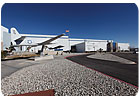
Lockheed Martin Aeronautics in Palmdale, CA, has maintained a VPP Star certification since earning it in 1999. The manufacturing facility there produces leading edges, radomes and antennas for the F-22 and F-35 Lightning II aircraft. Photo courtesy Lockheed Martin Aeronautics
Success Stories
On Oct. 31, 2007, ABB in New Berlin, WI, earned its first ever VPP Star award. The facility is the first and only ABB location to achieve this status.More than 500 people work at this facility, which includes three buildings that encompass 220,000 square feet. Workers at New Berlin manufacture energy-efficient, low-voltage electric drives and engineered drive systems for a wide range of industrial and commercial customers.
“We’re a true assembly shop,” says Rick Kegel, plant and safety engineer. “We don’t use any robots at this facility.”
Nearly 150 workers perform assembly, including extensive fastening with electric screwdrivers and nutrunners; wiring; soldering; and adhesive bonding. In 2010, the plant produced and shipped more than 175,000 products.
ABB’s journey to the Star award began back in July 2005, after it became one of the first U.S. companies to be OHSAS 18001 certified. OHSAS 18001 is an international standard for occupational health and safety management systems.
In late 2005, ABB turned its attention to the Star award. The company submitted its application in January 2006, but OSHA didn’t make its audit visit until July 2006. After the audit, ABB was told it had achieved Merit status rather than Star. The reason: Not enough employee involvement in its safety and health management system.
After ABB increased employee involvement, OSHA revisited in February 2007 and was impressed. ABB further increased employee involvement over the next eight months, and in October 2007, earned the VPP Star. Last fall, in October 2010, the company completed recertification and is awaiting OSHA’s approval.
ABB began improving its ergonomics program in 2006-before the facility even applied for the Star award. For example, the company purchased arm braces for assemblers to limit their exposure to vibration; adjustable-height pneumatic tables and pedestals to assure comfortable assembly; anti-fatigue mats; and hoists and cranes to assist in lifting heavy parts.
For ABB, the main benefit of winning the Star has been the opportunity to network with other VPP Star sites. “We get together and contact each other to assess and discuss best practices,” says Rich Bizek, North American safety manager. “We’re proud of the award, and safety is now a daily part of our culture.”
For the past 14 years, LENOX in East Longmeadow, MA, has maintained Star status. The company’s 500,000-square-foot facility initially earned this honor in 1997, making LENOX the first cutting-tool manufacturer in the United States to do so. LENOX earned recertification in 2000, 2005 and 2010.
Products made here include industrial band saw blades and hand tool blades, along with other power tool accessories. The facility employs 720 people, although only about 100 of them do assembly. There are two groups of assemblers. One group manually threads arbors onto hole saws. The second group welds the saws using specialized equipment.
“Earning our first Star was a two-year process,” says Mike Avery, director of safety and security. “But earning recertification was even harder to achieve. It was almost as if our first Star award never happened.”
During follow-up audits in 2000, 2005 and 2010, LENOX provided OSHA a series of notebooks, each of which detailed one component of the company’s enhanced health and safety management system. This greatly impressed OSHA during the evaluation, and helped LENOX maintain its Star status.
In 2008, in addition to the safety team, LENOX formed an internal ergonomics team. Soon after, ergonomics training took place, consisting of one- or two-day training sessions for the company’s managers and engineers. All other employees attended a two-hour overview.
The company also began making changes in the plant to improve ergonomics. Job rotation was instituted for high repetitive tasks, so people were not working the same body parts all day. Adjustable workstations also were installed for greater worker comfort.
In addition, equipment setup and plant lighting were re-evaluated and adjusted, anti-fatigue mats were placed in all assembly areas, and adjustable-height conveyors were installed in the shipping department. LENOX also began a mandatory, twice-per-day stretching program for all employees in high repetitive jobs, including a few office areas.
“It’s all about the well-being of our employees,” says Avery. “They have a better mindset when they work, focusing on safety and looking out for any problems.”
Another major benefit of the safety and health system is much lower workers’ compensation costs thanks to fewer accidents. Avery says LENOX paid $1.6 million in costs in 1996, but just $46,000 in 2010.
“Being awarded Star status has brought a sense of pride here, as well as cooperation among employees at all levels of the company,” says Avery. “OSHA is like a co-worker. It’s a true partnership.”
Out west, in Palmdale, CA, Lockheed Martin Aeronautics (LMA) has maintained a VPP Star certification since first earning it in 1999. More than 3,100 people work at the company’s Palmdale facility, which operates as a development and prototype organization with production of specialized parts for contracted aircraft programs.
“Next-generation manned and unmanned aircraft are developed and tested, but we do not perform high-rate final aircraft assembly,” says Jeff Ho, manager of the safety and health department.
Currently, the facility produces leading edges, radomes and antennas for the F-22 Raptor and F-35 Lightning II aircraft. Additionally, the facility maintains and modifies the U-2S Dragon Lady and recently retired F-117 Nighthawk aircraft.
LMA was awarded its Star through the VPP program of the California Div. of Occupational Safety and Health (Cal/OSHA). After LMA submitted its application in 1999, a Cal/OSHA team performed both a one-day initial site visit and a week-long audit.
The audit was performed by four Cal/OSHA team members and two special team members from VPP-certified companies. LMA was given a list of recommendations, which included an expansion of its ergonomics programs.
Once LMA addressed the recommendations to the team’s satisfaction, the company was granted Star certification. LMA has successfully maintained its Star status through two subsequent recertification visits, in 2003 and 2008.
“After the initial Cal/OSHA visit, we implemented a program where the company purchases ergonomic tools and equipment for different departments to evaluate,” says Ho. “Based on results, additional tools and equipment are procured by the site. We also hired an on-site physical therapist trained in ergonomics to conduct ergonomic evaluations and recommend corrective actions.”
After earning its first VPP Star, LMA began training many of its manufacturing and facilities engineers on ergonomics. The company also has an ergonomic expert evaluate new manufacturing processes to address ergonomic concerns.
To help assemblers, LMA has replaced many of its older power tools with new, lightweight, ergonomic tools. The company also installed rotating and adjustable trunnions and tooling on its manufacturing lines to eliminate awkward positions by workers as they perform composite layup.
“The Star award has made us much more responsive to safety concerns,” says Ho. “Where in the past we may have asked ‘Is it required by regulations?’ we now ask ‘Will it improve safety?’”
In Mesa, AZ, TRW Vehicle Safety Systems continues to maintain its Star status, which it earned in 2004, 2006 and 2009 from the Arizona Div. of Occupational Safety and Health (ADOSH). Nearly 400 people work at the TRW facility, which manufactures air bag inflators for all U.S. automakers, as well as several in Europe. The company makes three types of inflator-stored gas, pyrotechnic and hybrid.
Production is on the upswing, and the company estimates it will produce 180,000 to 190,000 units per week in 2011. The inflators are used in driver-side, passenger, side-impact, knee-bolster, rollover and other types of air bags.
Assembly is mostly automated and involves welding, crimping or press fitting of inflator parts. Some assembly lines are fully automated, while others feature automated and manual processes. On fully automated lines, conveyors bring parts to the welding, crimping or pressing equipment. On mixed lines, workers place one or more parts in a workstation every 6 to 7 seconds, then flip a switch to activate the equipment.
“Adhesives are used to join parts on certain driver-side bag inflators,” says Scott Detwiler, health, safety and environmental manager. “The dispensing and pressing is fully automated.”
TRW began using ADOSH’s VPP guidelines as a benchmark in 2002 to improve its safety and ergonomics programs. Over the next year or so, the company hired a consultant to create a more detailed job-hazard analysis of each workstation. TRW also hired an ergonomist to educate workers on body mechanics and posture.
In 2003, TRW invited ADOSH to do a preaudit. TRW continued to improve its safety and ergonomics program, then submitted its VPP application and completed the on-site audit in early 2004. A few months later, ADOSH awarded TRW the Star.
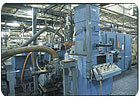
Products made by LENOX in East Longmeadow, MA, include band saw blades and hand tool blades. Shown is an electron beam welding machine on the manufacturing floor. Photo courtesy LENOX
Improving ergonomics is an ongoing priority. Changes in recent years include better lighting, adjusting the height of equipment, and redesigning workstations to minimize worker movements.
“VPP is a great way to promote involvement,” Detwiler says. “Great safety and ergonomics programs are the result of employees and management working together.”

